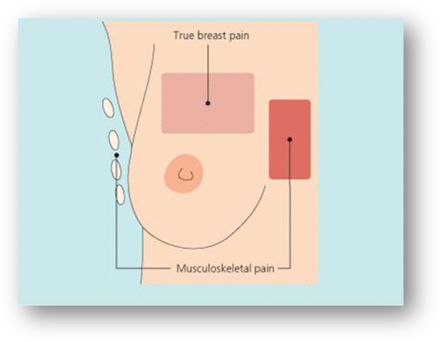Introduction

- General mastalgia (breast pain) is a common complaint by many women
- Mastalgia can be caused by multiple factors
- Breast pain rarely is a symptom of breast cancer
Mastalgia Categories
Mastalgia is divided into 3 categories:
- Cyclic
- Non-Cyclic
- Extramammary
Causation should be established
- Some women may experience a change in quality of life and need to explore treatment options
Incidence Rate
Up to 70% of women will experience breast pain at some point in their life

10% of women with breast pain may experience change of life and will require some type of pain-relieving treatment.
Reference
Crochetiere C, 2005
Etiology of General Mastalgia in Normal Breasts
Physical Activity: (Cause for Non Cyclic and Extramammary Breast Pain)
- Trauma to breast (breast blow)
- Costochondritis
Medications
- Antipsychotics
- Oxymetholone
- Chlorpromazine
- Diuretics
- Digitalis preparations
- Methyldopa
- Spironolactone
Hormones
- Estrogen
- Progesterone
- Oral contraception
- Clomiphene
Reference
Rodden AM, 2009; Smith RL et al., 2004; Breast Pain, 2014
Exam for Mastalgia
- Patient History
- Patient describes pain, location of pain, relation to their menstrual cycle or any physical activity, interference with their daily living and any family/personal history of breast cancer
- Obtain medication history, medical conditions, caffeine intake, stress level, smoking status
- Physical breast examination (Click for more information on next slide)
- Entire breast area should be examined (lymph nodes, cervical and thoracic spine, chest wall, and arm pits)
- Patient should be in supine position in an effort to determine if pain is extramammary or breast pain
- If breast mass is felt during the examination – refer for radiographic work
Breast or Extramammary Pain
It can be difficult to determine if the pain is in the breast or if extramammary or musculoskeletal pain.

Reference
© Iddon J, & Dixon JM (2013). Used by permission
http://www.bmj.com/content/347/bmj.f3288?variant=long&sso=
Differentiating Breast or Extramammary Pain
- Have patient lay on her side so the breast falls from chest
- Examine discomfort in muscles of the chest wall and question if pain during exam is similar to usual pain experienced
- If there is pain in the lower part of the breast, underlying chest wall is examined
- Lift the breast with one hand and exam the chest wall with the other hand
- Have the patient confirm if that is the area for maximal pain and tenderness
- This will help determine if the pain is in the breast or if it is extramammary
Treatment for Mastalgia
Treatment for mastalgia typically consists of:
- Medical Treatment
- Reassurance for the Patient
- Alternative Treatments

A majority of patients are treated with simple reassurance. 85% do not require medical treatment. Only 15% require medical treatment for mastalgia.
Treatment Steps
- Etiologic treatment
- Symptomatic treatment
- Reassurance
- Follow-up
Hormone-Related Treatment
| Hormonal Treatment | Discussion |
|---|---|
| Danazol |
|
| Tamoxifen |
|
| Bromcriptine |
|
| Centchroman |
|
| Lisuride |
|
| Goserelin (Zoladex) |
|
Medication-Related Treatment
| Pain Treatments | Discussion |
|---|---|
| Nonsteroidal anti-inflammatory drugs (NSAIDS) |
|
| Acetaminophen |
|
Reference
Breast pain, 2005; Onstad M, & Stuckey A, 2013; Amin AL, et al., 2013; Colak T, et al., 2003; Tejwani PK, et al., 2010; Rodden AM, 2009
Considerations for Mastalgia Treatment
Reassurance for The Patient
- Women sometimes fear breast pain may indicate breast cancer
- Women just need simple reassurance
- Non-randomized studies have found reassurance is effective in 70% of women
- Breast pain is not a major symptom of breast cancer
- In a study conducted at symptomatic breast unit in Ireland, 5,841 patients were referred with mastalgia
- 3,331 (57%) of those 5,841 reported mastalgia as their only symptom
- Patients who reported their only symptom was mastalgia had a breast cancer incidence rate of 1.2%
- Of those diagnosed with beast cancer, all were over the age of 35
- In a study conducted at symptomatic breast unit in Ireland, 5,841 patients were referred with mastalgia
- Overall prevalence of breast cancer in women with mastalgia is 0-3.2%
Alternative Treatments
| Supportive bra |
|
|---|---|
| Avoid caffeine and nicotine |
|
| Very low-fat and reduced sodium diet |
|
| Massage with Ice packs/heat compress |
|
| Primrose oil |
|
| Fish oil supplements |
|
| Relaxation therapy |
|
Reference
Breast pain, 2005; Onstad M, & Stuckey A, 2013; Amin AL, et al., 2013; Colak T, et al, 2003; Rodden AM, 2009

